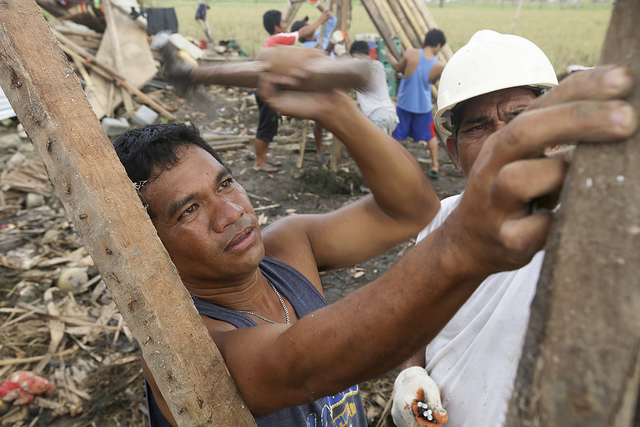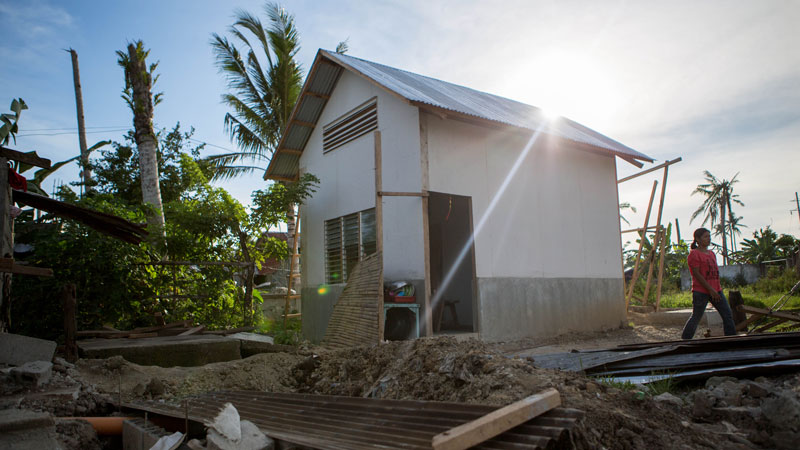Philippines typhoon: preparing for the future

Nick Harrop, World News Officer for CAFOD, writes:
Three weeks ago, Typhoon Koppu battered the Philippines. After making landfall near the town of Casiguran, the typhoon travelled slowly across Luzon island, ripping roofs off poorly constructed homes, cutting off power supplies, and flooding huge swathes of farmland. In some areas the storm dumped 130 cm of rain over just two days – more than twice as much rainfall as London experiences in an entire year.
Join Catholics worldwide in calling for urgent action on climate change
During the typhoon, Luzon island was also hit by a magnitude 5.8 earthquake. In Britain, the quake would have dominated the front pages for weeks; we haven’t experienced a tremor that powerful since the year 1590. In the Philippines, it went virtually unreported.
To say that the Philippines is hit by a lot of disasters is an understatement. Koppu wasn’t the first typhoon to strike this year – it was the twelfth – and it wasn’t even the most powerful. There have also been more than a dozen deadly earthquakes in the country since the beginning of the 21st century, as well as floods, droughts and volcanic eruptions.
But no recent disaster has been more devastating than Typhoon Haiyan, which hit the Philippines on 8 November 2013. The so-called ‘super-typhoon’ was one of the most powerful storms ever to make landfall, tearing apart the lives of 14 million people and leaving five million homeless.
Like a war-zone
I remember arriving in the city of Tacloban a few days after Haiyan hit. Winds of up to 200mph had torn off roofs, while a storm surge – a wave of water the height of a house – had carried cars, trees and whole buildings hundreds of metres inland.
Even climbing off the plane was shocking. The roof of the airport had been blown away, and the terminal’s entire first floor had disappeared. Driving south through the city was like driving through a war-zone. I didn’t spot a single building that hadn’t been damaged. Most homes had been flattened. For miles, there were nothing more than twisted steel shells and piles of wood.

Corazon, 71, had stayed in her house during the typhoon, and was lucky to have survived. She told me: “There was a very big difference between this typhoon and other typhoons. It was very loud and the wind was very strong. It looked like it was evening, even though it was only 10 in the morning.
“I was alone in my house when the typhoon hit. All I did was pray the rosary. Then the house collapsed on top of me. The roof and the walls fell down and I was injured. I felt numb. I thought it was the end. I was caught under the debris and my nephews had to pull me out. I wasn’t able to walk, because I was shaking and trembling, so they carried me.
“I lost my home, my clothes, my TV, my kitchenware and all my animals. The only thing I saved was my rosary. Caritas [CAFOD’s partner] gave me food, but life has been very difficult.”
Preparing for the future
In the aftermath of Typhoon Haiyan, Catholics in England and Wales donated an amazing £5.4 million to CAFOD’s Philippines Typhoon appeal. Thanks to their compassion, CAFOD’s Church partners were able to reach tens of thousands of people with food, shelter kits, safe water and emergency supplies. Since then, they have helped thousands more to find new ways of making a living, as well as rebuilding hundreds of houses and schools.
Two years on, our priority is to make sure that people are better prepared for future disasters. As Typhoon Koppu reminded us three weeks ago, there will unquestionably be more typhoons and earthquakes in the Philippines. It is crucial that people can live in safe homes, and have clear plans of what to do in an emergency.

Today, Corazon has moved into a new home with a concrete base, a galvanised iron roof and white hardiflex walls. The structure was built from treated coconut timber salvaged after the typhoon. Local carpenters and expert architects ensured that it was structurally sound enough to withstand future typhoons.
Corazon asked me to pass on this message to the people who paid for her new home: “I am very thankful for my new house. Thank you for caring and looking after us. May God give you good health.”
Importantly, our local Church partners are now also better prepared for disasters. Before Typhoon Koppu hit last month, Caritas Philippines – which manages the Church response to emergencies across the country – formed an emergency team that could be deployed rapidly, while local diocesan teams prepositioned stocks of relief supplies. Once the typhoon had passed, priests, volunteers and Church workers were ready to start distributing food, hygiene kits, sleeping mats, mosquito nets and shelter materials immediately.
Monseigneur Meliton Oso, who has coordinated the Church’s response to Typhoon Haiyan in the Archdiocese of Jaro, said: “Our response is not just about giving people shelter, but also giving them hope, giving them a sense of preparedness for the future. This is a response in faith. This is the response that the Gospel demands.”
Help us respond to emergencies as soon as they happen
Join Catholics worldwide in calling for urgent action on climate change